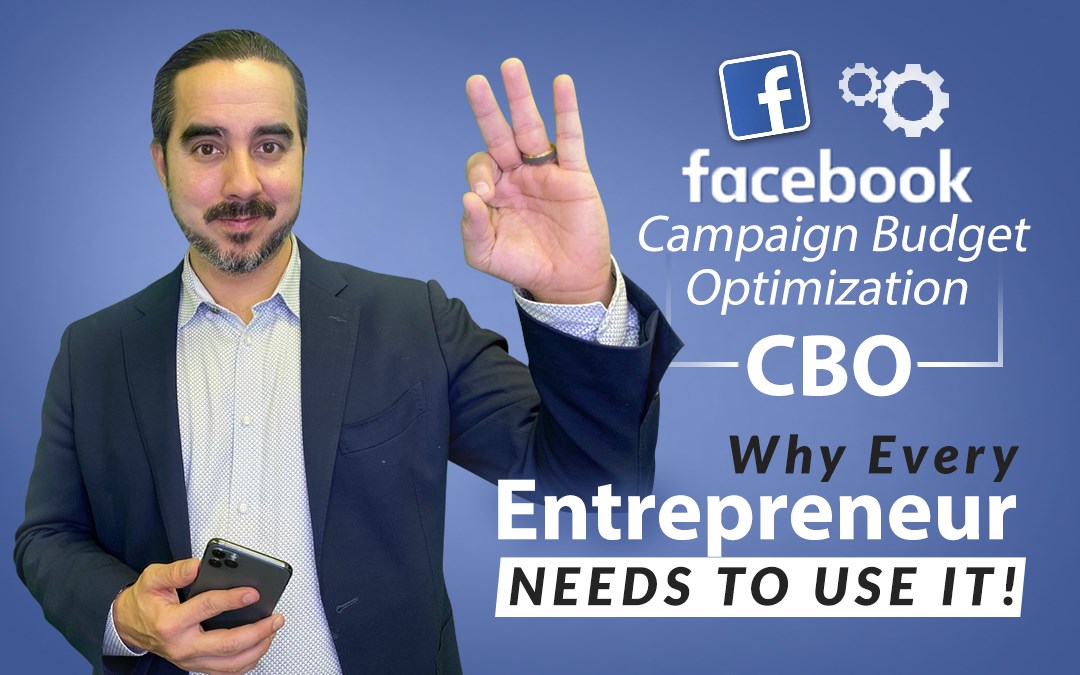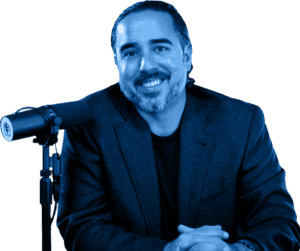DESCRIPCIÓN DEL PODCAST
In this episode, Manuel gets technical on the Facebook ad side of things.
However, if you are interested in Facebook ads, you will want to listen in.
Manuel goes over the vital elements that make up an ad campaign including why CBO, Campaign Budget Optimization, should be a part of it.
If you have spent some time with Facebook ads and want to improve the results of your ads, or want to stop wasting time and money on learning Facebook ads, this episode is for you!
ARCHIVO DEL PODCAST
Facebook Campaign Budget Optimization (CBO): Why Every Entrepreneur Needs to Use It!
De clic aquí para descargar este Podcast >>
DESCRIPCIÓN DEL PODCAST
Jules: Hey guys, this is Jules. I’m Manuel’s Creative Director.
Now, this podcast is a little technical, but if you’ve ever had an interest in Facebook ads, you’ll definitely want to listen in.
Manuel will breakdown the vital elements that make up a campaign, including why CBO aka Campaign Budget Optimization needs to be part of it.
I hope you enjoy the podcast.
3 Things to Remember When Creating a Campaign

Manuel: So here’s a quick recap. If you guys have some familiarity with the Facebook Business Manager, you already know that when you’re going to create a campaign, generally, there’s three things that you have to get done always, religiously. If you don’t do them, you don’t have a campaign, all right?
- You have to create select the campaign that has an objective.
- You have to select an audience; and.
- You also have to select an ad.
Those three things combined complete a campaign creation process.
What is a Campaign?
Now, a campaign, just to recap, is where you select:
- What is it that you’re trying to accomplish
- What is your overall goal for the campaign
- Do you want to get traffic to your listings on Amazon
- Do you want to generate conversions on your website off of Amazon
- Are you trying to generate leads? And that way you do actually a conversion or a lead generation campaign
- Do you want to just get branding and do video views and get people to see your content
- Get exposure
- Do you want to get messages on your Messenger channel
- What do you want to do
And this is where you decide that particular step before you do anything else. You’ve got to be in communication with Facebook because the more data that you give Facebook, the better information they can use to help you get results.
It’s important because they are trying to get you to get results.
What happens if you get results as a brand using Facebook?
Facebook gets more money.
They’re not trying to just make you happy. They’re trying to make more money and results are what help them get more budgets, get more people investing money. And people like me, who I’m a big Facebook and social media proponent to talk to the world about the opportunities of social media.
So results are a big part of your process of going through and becoming a social media advertiser yourself. If they don’t give you results, you quit.
So they are trying really hard to give you results, contrary to popular belief out there. So don’t listen to the haters out there. Don’t pay attention to them.
You’ve got to maximize your own opportunities and know what to leverage and how to take advantage of them overall. Okay.
Campaign
Tell them what you want.
Ad Set
Who is your audience? Who do you want to reach? What do you think is your target demographic?
And this is what you select that demographic right there. As you may or may not know, we’re going to probably talk about audiences some more. Probably some more on the next few segments. But, an audience can be extremely bad, meaning that they have no interest or it can be the perfect one.
I always like to say to my students:
Look, the worst advertising in the world is going to give results to the best audience.
All right. If you’re putting a product in front of a person that has a problem, even if your ads are not great looking, you might get results.
Now, the most incredible advertising in the world, the best creative in the world are not going to give results to the wrong audience. That’s just the way it is.
So audience is your bread and butter, and you want to figure that out. And this is where CBO, Campaign Budget Optimization, comes in. You know, I’ll explain to that some more later on.
But on the audience section, which is also called the Ad Set section, you’re going to select what is the offer, what placement are you selecting, what is your budget and your schedule? All those things are selected at that point. And you’re going to just basically go through the process.
Ad
And the last step, the third and final step is going to be the ad.
What is your image? Your video, your copy, your call to action, your description, how are you going to communicate the value of what people get if they go and follow your directions of visiting a link, going to a Messenger channel or whatever it is that you’re trying to accomplish.
Those are the three levels that any campaign ever in social media are going to revolve around. And you’ve got to have those really clearly before you actually get going.
Now that we got that recap,
What is Campaign Budget Optimization (CBO)?
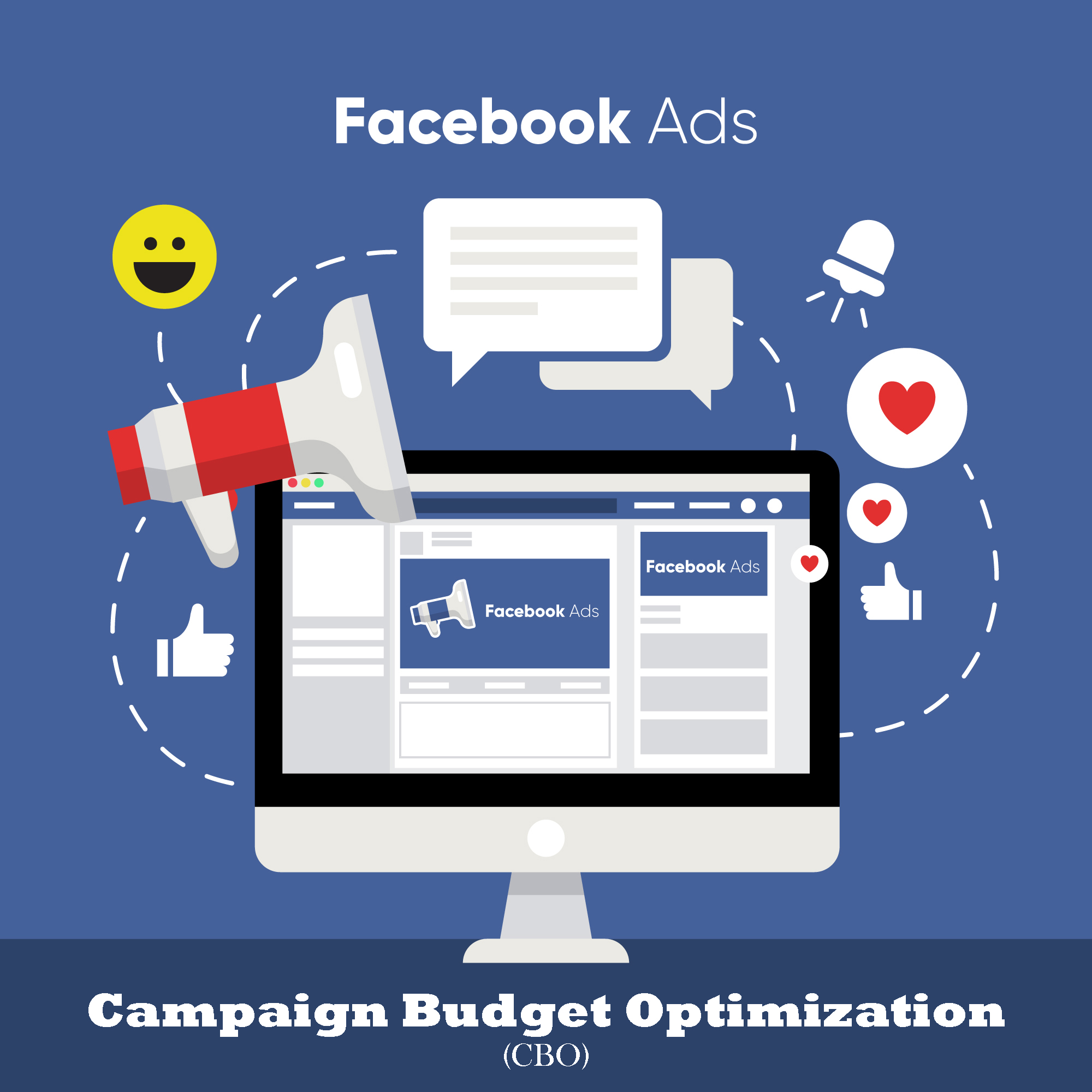
If you haven’t heard about this before, well, get ready because it’s actually mind bending and super powerful. And it’s a game changer for us advertisers because it makes things a lot easier.
Campaign Budget Optimization is a way of optimizing distribution of a campaign budget across your campaign’s Ad Sets. This means Facebook automatically and continuously finds the best available opportunities for results across your Ad Sets and distributes your campaign budget in real time to get those results.
You got it. They are going to help you find winning audiences. All you’ve got to do is plug them in and they will help you. So right now, again, things change really fast. So if you’re watching this training in 2020 at some point or in December, it might have changed already.
This is the game that I played. This is what I live every single day. I have to continuously update my training because Facebook is always updating and changing the platform. But right now, as of today, this is the way it looks.
If you are at the campaign level, you’re going to select the campaign name, and there’s going to be an option right there that says Budget Optimization. And if you toggle that thing on, it’s going to optimize your budget across Ad Sets.
So in short:
You don’t select a budget per audience.
You select a budget per campaign.
And all you’ve got to do is plug it there a bunch of audiences up to 70 of them, more on that later. And Facebook will optimize towards the best performing one. So, instead of wasting money trying to discover winning audiences,
Facebook will help you find winners for you and save you money. It sounds pretty powerful, right? I believe so, too.
- A Campaign Budget is a budget you set at the campaign level rather than the Ad Set level. The amount you set can apply to each day the campaign runs (daily budget) or over the lifetime of the campaign (lifetime budget). You can do a daily or you can do a lifetime. That’s all decided at the campaign level. All campaign budgets use campaign budget optimization.
- Facebook optimizes your campaign budget in real time on an opportunity-by-opportunity basis. That’s based on what they’re observing in real time across users in social media, including Instagram, Facebook, Messenger, and not to distant future platforms like WhatsApp. Their goal is to get you the most results possible, and for the cost of those results to align with what your bid strategy is.
What are you trying to accomplish?
Are you trying to get clicks for pennies on the dollar? Are you trying to get conversions for a dollar or two dollars, depending on what you’re trying to accomplish? They help you get results for that.
How Does it Work?
Let’s use an example Facebook provides in their documentation. Assume you have three Ad Sets and spend $10 per Ad Set.
Without CBO, Facebook will attempt to spend $10 per Ad Set, regardless of performance.
So maybe the worst audience that you could have ever found doesn’t get any results, people hate your ads, but Facebook will still spend the money. And then the other one which is an incredible audience performing incredibly well, converting like crazy clicks and pennies and conversions are very low, well, they still get the same amount of money spent on them. That’s not making us really happy, right? You cannot really scale that.
With campaign budget optimization, Facebook will react to the performance of each of your Ad Sets. You might then instead spend more or less per Ad Set to get the most results.
Pretty cool, right? Okay, good. So let me show you here a visual representation.
An Example – Without CBO
So without CBO on the left side, campaign, you’ve got Ad Set 1, 2, 3. 10, 10, 10. So you’re getting conversions a total of 10 conversions.
Now, on the first Ad Set, you got three conversions and you spent $10. On the second one, you got five and you spent $10. On the third one, you got two conversions and you spent $10.
Why would you spend the same amount of money on an audience that is not performing as well? Well, that’s the way that it’s been forever before CBO.
An Example – With CBO
This is the example with CBO on the right side of your screen right now.
Campaign Ad Set 1, 2, and 3, the campaigns are spending money. And then, it realizes that, that first Ad Set and the third Ad Set are not getting as much results. So it starts spending the money on the middle Ad Sets. So now you get 1, 2, 3, 4, 5, 6, 7, 8, you get 10 conversions on that middle Ad Set. And on the other ones, you get 3, and then you get 2. But then Facebook continues to optimize towards the one that’s performing the best. That’s the value of CBO.
Best Practices for Campaign Budget Optimization
So, a couple of best practices:
I. Use ad spend limits sparingly, or not at all.
What do I mean by that? Do not adjust the Ad Set inside the Campaign Budget Optimization. Just let the campaign do its job because it’s going to optimize based on the result. The more budget that’s locked into specific Ad Sets, the less flexibility the delivery system has to optimize your campaign budget.
II. Any campaign using Campaign Budget Optimization, you can add up to 70 Ad Sets inside
– up to 70 Ad Sets.
Meaning that you can actually just figure it out how to find 70 audiences. You don’t have to do 70. It’s a lot of work. But let’s say for example that you have 10 audiences of customers, video watchers, people that have messaged your page, people that have visited your website, purchasers, people that have not bought from you in a year, you can have all these audiences. Then you can have 10 lookalike audiences.
And now you can also have 20 interest-based audiences that you’re finding on Facebook, based on the things that they have shown an interest in. And you can just plug them all in and Facebook will rotate your money and spend it where they’re getting the most results. And that’s the value of it.
III. Ensure all Ad Sets in your campaign can be delivered
If an Ad Set isn’t delivering, let’s say the budget is too low of the overall campaign or the bid strategy is too low, it isn’t encouraging any opportunities for result. This means we can distribute budget to it. Campaign budget optimization works best when all Ad Sets in a campaign could spend a full budget, but you get to pick only the best results from each one. If any of your Ad Sets aren’t delivering, try increasing your bid caps or target costs.
Meaning that there’s going to be an option at the Ad Set level where you can actually have a manual bid cap or target cost and increase that to try to get more delivery, all right?
Adjusting your targeting and creative or switching to a more common optimization event is also an option.
If you’re not getting delivery, you can adjust your image, your copy, and it might start getting more delivery along the way. Those are things that you can do to get that handled.
CBO is Recommended Specifically to Those Who Want to:
1. Set a campaign level budget and have some flexibility in how that budget is spent across the Ad Sets in their campaign.
2. Get the most results possible from their campaign; and
3. Simplify campaign set up and save time by reducing the number of budgets they have to manage manually. I’ll give you some examples of that.
Campaign Overall Structure
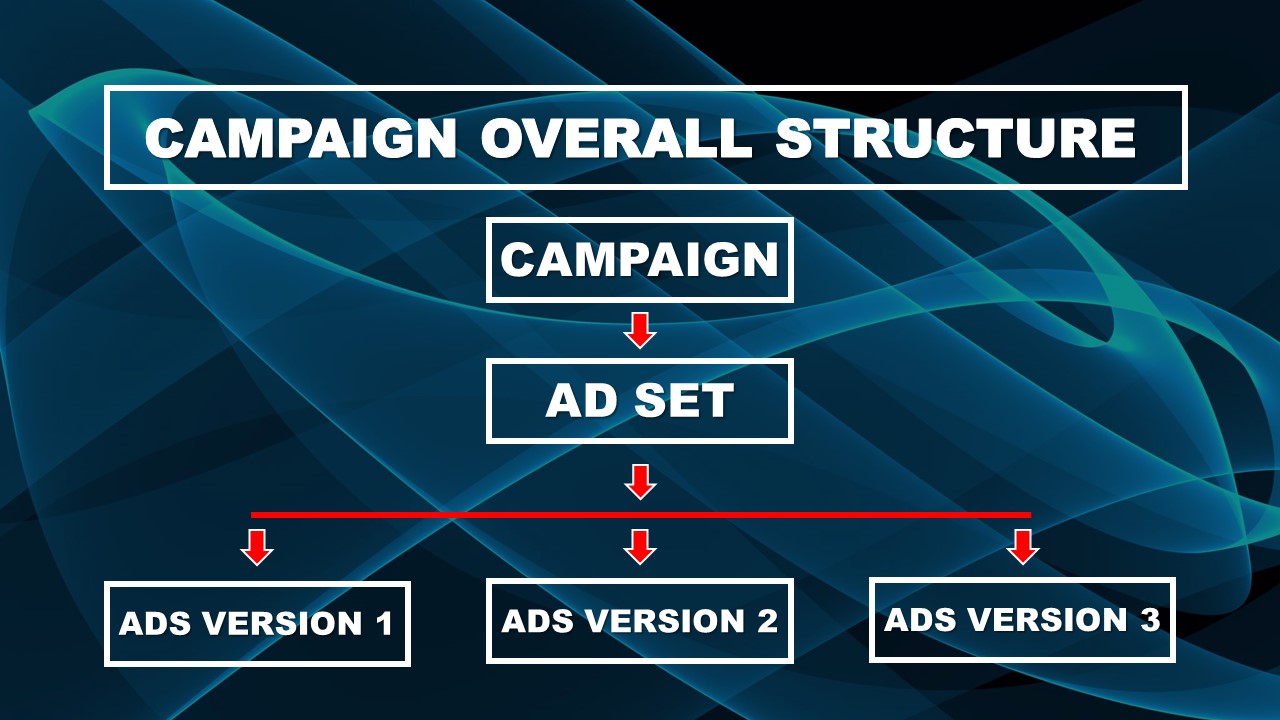
You’ve got one campaign and then you’ve got an Ad Set. And then you’ve got Ads Version 1, Version 2, and Version 3, all right?
So now, the way that this looks right here, you can see that it’s one campaign.
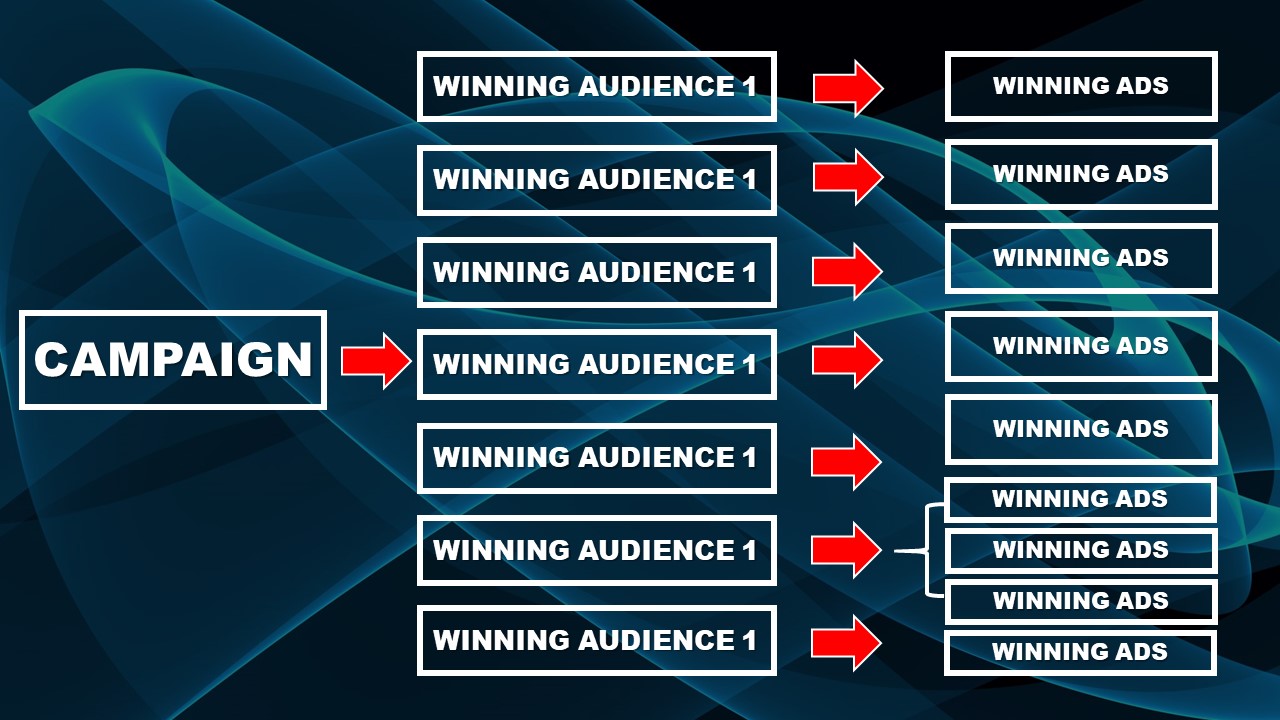
And then we’re going to find those winning audiences 1, 2, 3, 4, 5, 6, 7, and then we’re going to find those winning ads also along the way. And those are the ones that are going to keep on.
Usually, we like to test out three separate ad creative, meaning a single image, a single video, a carousel ad, variations of copy. And then we’re going to look at the results on each one. And the one that is performing the best, those are the ones that I leave on. And if the other ones are not performing well, I turn off the ads that are under each Ad Set. Make sense? All right.
Naming Convention
I. Campaign Level
So the naming convention at the Campaign Level. So name the campaign based on the chosen objective.
There’s seven campaigns in total that you can possibly have. For example, you can have:
- Conversions Campaign
- Traffic Campaign
- Messenger Campaign
- Campaña de visualizaciones de vídeos:
- Engagement Campaign
- Branding and Reach Campaign
- Catalog or Dynamic Ads Campaign
Now, for an Amazon seller, most cases, if you have Zon Tracker like I have recommended, you can run conversions campaign and you can run traffic campaigns.
If you don’t have Zon Tracker, generally, your campaign objective is going to be Traffic, but you can also do Messenger or you can also do Video Views.
Those are the ones that I recommend the most, because if you do Messenger or Video Views, you can get people from social media to Messenger, give them a coupon for a discount and get them back to Amazon. So you can actually do that and that could be the process.
Video Views, you can grab a cool video and invite them to visit your website after they complete watching the video. So that also works, but generally the most common option for Amazon sellers is going to be Traffic even though since you guys have gotten from my training, I do recommend aggressively that you get the Zon Tracker set up, which is going to be bencummings.com/zon, Z-O-N, if you haven’t done that yet.
And you can get that set up and now you can optimize for conversions that is going to get the right signals to Facebook that you’re looking for people to purchase your products on Amazon, not just visit the listing, but actually go through the process of purchasing.
II. Ad Set Level
This is the way that you will name that convention. So on the example here, we’re choosing Conversions Dr. Berg. So at the Ad Set level, we want to base it on… This is important guys, because you want to make sure that you don’t get… Your ad account doesn’t get confusing.
You want to have naming conventions that are very easy to locate exactly what was meant, what were you trying to communicate at that particular point. So what would you name the Ad Set based on the targeting used?
Well, example:
- Warm or Cold = W/C
- Product Promoted = KETO KIT
- Audience Selected – VIDEO WATCHERS 50%
(People that watched the content for 50% or more)
- Demographics = ALL GENDER 25-54
And that results in the following:
W – KETO KIT – VIDEO WATCHERS 50% – ALL 25-54
And now I know exactly just by looking at that, who is in that audience there. Again, I can do up to 70 of these on a campaign budget optimization campaign.
III. Ad Level
At the Ad Level, very simple.
- Type of Creative = VIDEO SQUARE
- Product Shown on Creative = KETO KIT FAQ.
VIDEO – KETO KIT FAQ
As you can see right here on the examples on this screenshot, Digest Formula FAQ VIDEO V2, ADRENAL CORTISOL IMAGE, ADRENAL CORTISOL FAQ VIDEO, just like that.
So just to recap, the Campaign Budget Optimization is going to be an essential part of you getting results as an Amazon seller and as a brand, even if you’re trying to build a brand off of Amazon, CBO needs to be an essential part of it.
Remember, Facebook is trying to help you get more results. The more results you get, the more money you give them.
So it’s important to understand that they are not trying to take your money away. They’re trying to help you be successful. Once you understand that, you understand that the things that they’re developing along the way are meant to give you better and better quality results, every step of the way.
So CBO, make sure you turn those things on when you’re doing campaigns, set up your audiences inside up to 70 of them. I can tell you that anywhere from 10 to 20 audiences is great. If you do 40 because you have the time to go ahead and create 40 audiences in there.
Audience Overlapping
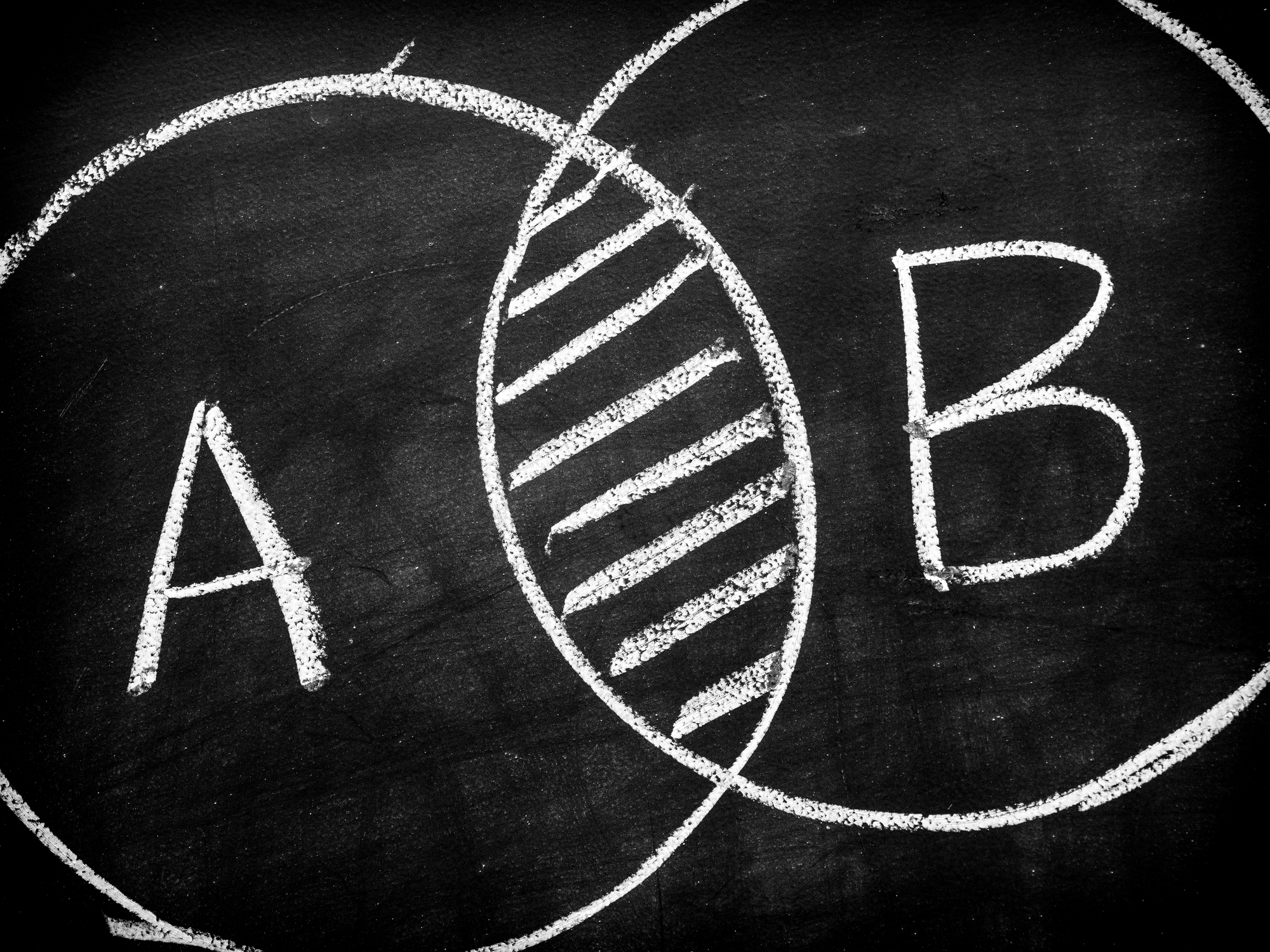
Another thing that I want to mention before we end about the CBO is that, you know, there’s something called Audience Overlapping.
I’ll give you a little show over here on the board. When you have an Audience Overlap, let’s say that you have a campaign and you set up different audiences inside. If you don’t select audience Campaign Budget Optimization, this is what could happen.
You can do this and then you add another audience and it goes like that. And then like that and like that. So if you plug in four audiences, there is an overlap. Some people that are on this audience are also on this audience. Some people that are on this audience are also in this audience and et cetera. You get the idea, right?
When you do Campaign Budget Optimization, you can do 70 audiences. And even if they don’t have similar interests, there is no overlapping. These are all individual campaigns, completely separated from the other one.
So if there’s somebody in here that has the same interest as this one, they’re either going to be on here or on here. That is a value also that you want to keep in mind when you’re doing CBO. And it’s as simple as toggling that little switch on.
If you toggle it on, you’re going to be able to turn this thing on. And now you can have campaigns with up to 70 audiences that are not overlapping, and you can have Facebook working for you even while you’re sleeping. And you can have them helping you find winning audiences that are going to be spending the most money. And then the losers that are here do not get any money spent.
Example: This guy right here is getting $1.57 a click. This one right here is getting ¢27 a click. Facebook starts putting energy towards this one and starts eliminating these guys from the equation. And that’s the value of that. They work for you.
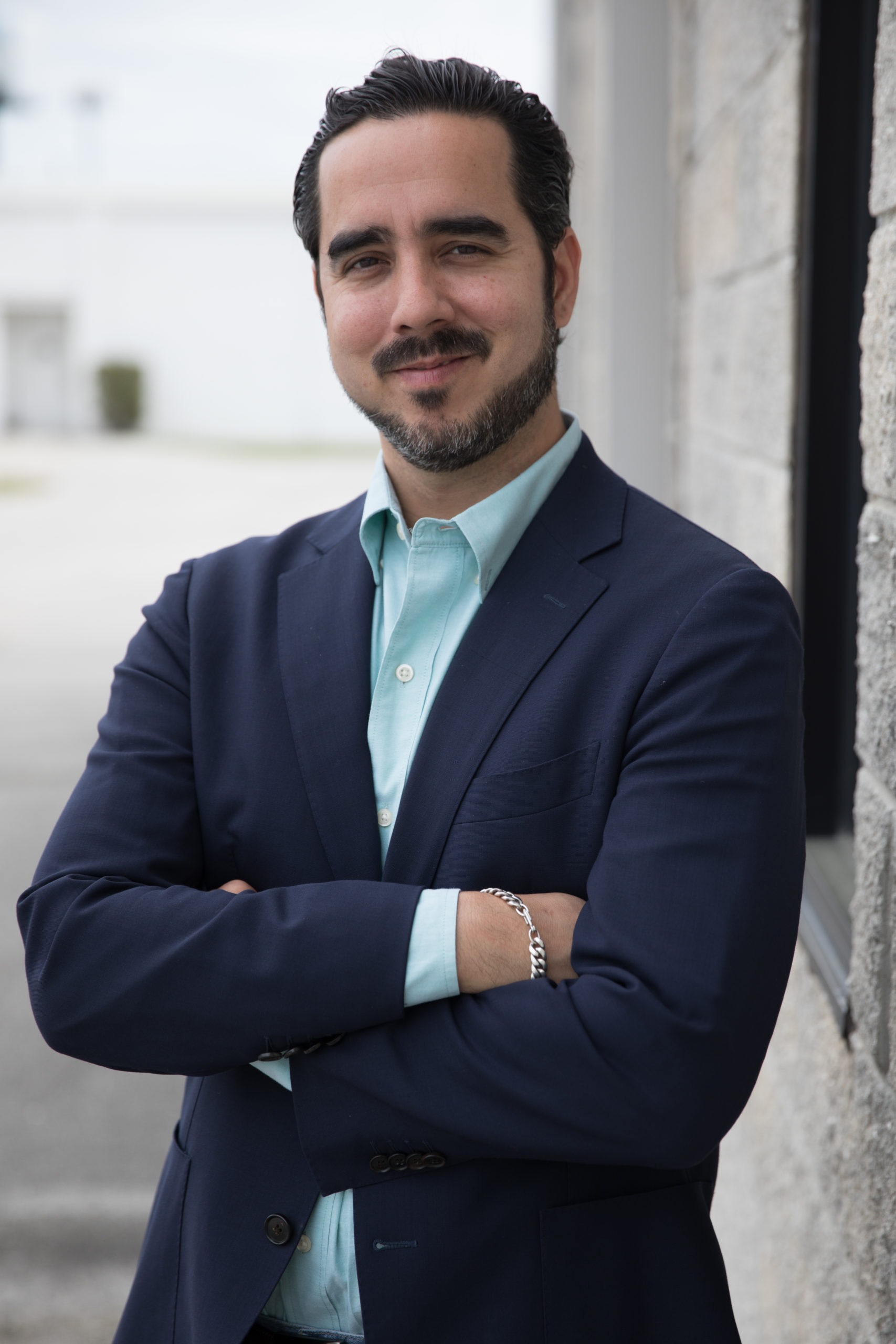
Haz los minicursos de Facebook Ads GRATIS aquí: agmninjalab.com/free-mini-course manuelsuarez.com/minicourses
Estoy publicando mucho contenido excelente todos los días. ¡Asegúrate de seguirme en tus plataformas favoritas! Aquí están los enlaces:
FACEBOOK: www.facebook.com/theninjamarketer/
Messenger Channel: www.m.me/theninjamarketer/
Instagram: https://www.instagram.com/mrmanuelsuarez/
LinkedIn: https://www.linkedin.com/in/mrmanuelsuarez/
YouTube: https://www.youtube.com/c/TheFacebookNinjaMarketer
Póngase en contacto con la Agencia AGM hoy para programar su consulta gratuita: contact@agmagency.com/
